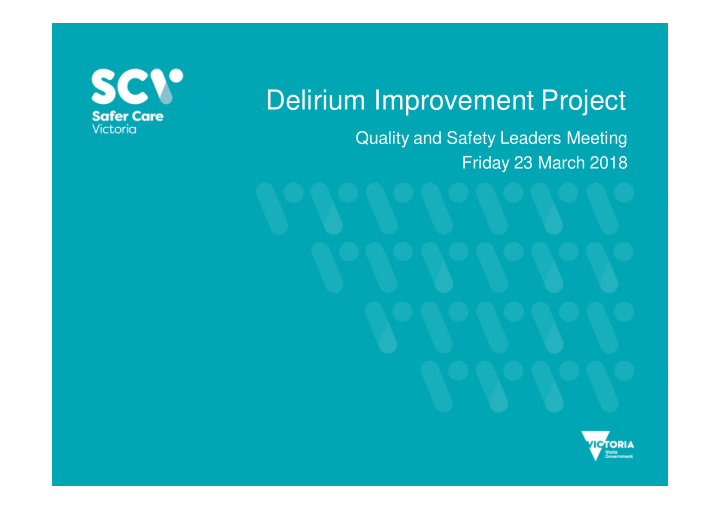



Delirium Improvement Project Quality and Safety Leaders Meeting Friday 23 March 2018
Why is delirium a priority for SCV? • Increase in serious incidents involving delirium • 3rd most common hospital acquired complication in Australia • Associated with severe adverse events • Preventable in 30-40% cases • Recent release of Delirium Clinical Care Standard
Delirium in Victoria • For Victorian patients aged over >65 years Delirium vs No delirium 8.1% Mortality 2.6% 14.9% + ICU 10.6% 15.2% + Septicaemia 10.6% 10.6 days Length of stay 5.6 3.07 WIES Cost 1.68 WIES • For Victorian patients aged over >65 years WITH DELIRIUM Regional/rural Vs Metro 10.1% Mortality 6.6% 12.2 days Length of stay 9.4 days
Prevalence In Victoria…. Prevalence of delirium is 0.5% = 6600 observed cases In the literature… Prevalence of delirium is 11-68% = 145,200 - 897,600 observed cases 138-600 – 891,000 missed cases each year Between 30-40% of delirium cases are preventable… 11% = 43,560-58,080 preventable cases each year 68% = 269,280 – 359,040 preventable cases each year
Delirium Improvement Project • 18-24 month multidisciplinary project led by Safer Care Victoria Aim • To improve the screening, prevention and management of hospital acquired delirium in Victorian public hospitals Outputs • SCV endorsed delirium screening tool, delirium management pathway, revised clinical practice guideline, improvement sector forums, patient, family & clinician education resources, point prevalence survey methodology
Pilot point prevalence survey Primary aim To test a methodology for conducting a point prevalence survey of delirium in the Victorian public inpatient population Secondary aims To determine: • the prevalence of delirium and cognitive impairment • the difference between measured prevalence and reported prevalence • the characteristics of patients with or at risk of delirium • the frequency of physical and chemical restraint use • the frequency of adverse events (falls and pressure injuries) • Overall and by health service, hospital, ward and treating speciality • Patients at risk of or identified as having hospital acquired delirium
Pilot point prevalence survey Design • ‘Staggered’ point prevalence survey design • Study site coordinators to coordinator survey in health services • Surveyors recruited locally to collect data • Registered nurses, allied health, quality managers • Receive training in survey protocol and remuneration for time • Receive resources and support Method • 4 health services, 12 hospitals, 1048 beds • 4 study site coordinators, 34 surveyors • 23 days of data collection, 6 hours per day, 0.5 hours per bed
Pilot point prevalence survey Data sources Primary aims Secondary aims: Resource data • 4AT assessment tool • People, time, cost • Participant observation Training evaluation • Medical record review • Study site coordinator • Data linkage (post hoc) • Surveyors Role evaluation • Study site coordinator • Paper • Surveyors • Electronic
Pilot point prevalence survey Demographics • Age, gender, language, Aboriginal and Torres Strait Islander, Charslon comorbidity index Physical restraint • Nursing special/sitter, arm or leg shackles, mitts, bed sheets tucked/doubled/tied across torso, posey vest or seat belt, low chair, tray table fixed to chair, bucket chair, concave mattress, both cot-sides up, bed against wall with near cot-side up Chemical restraint • Administered in previous 24 hours • Alprazolam, clonidine, haloperidol, lorazepam, olanzapine, oxazepam, quetiapine, risperidone • New prescription this admission • Stat, PRN or regular administration • Indication other than diagnosed psychiatric condition or pain relief
Pilot point prevalence survey Risk factors • Age • Known cognitive impairment • Current hip fracture • Severe medical illness – Modified Early Warning Score (Subbe et al., 2001) Score Physiological parameter 3 2 1 0 1 2 3 ≥ 200 Systolic blood pressure (mmHg) < 70 71-80 81-100 101-199 ≥ 130 Heart rate (bpm) <40 41-50 51-100 101-110 111-129 ≥ 30 Respiratory rate (bpm) < 9 9-14 15-20 21-29 ≥ 38.5 T emperature (ºC) < 35 35-38.4 AVPU score A V P U
Pilot point prevalence survey Participants: Hospitals
Pilot point prevalence survey Participants: Wards/treating specialities Included Excluded Acute Same-day admissions (medical, surgical, specialist medicine) (dialysis, chemotherapy., day surgery) Sub-acute Emergency departments (geriatric medicine & rehabilitation) (short stay & urgent care centres) Palliative care wards Mental health High dependency units Paediatric Intensive care units Maternity Outlier specialities on included wards
Pilot point prevalence survey Participants: Patients Included Excluded In-patients Aged < 18 years Aged ≥ 18 years Physically aggressive (safety risk) Non-English speaking Too critically ill to participate Post-anaesthetic care unit transfer Severe aphasia or non verbal Isolated due to immunocompromise Comatose Intellectual disability Imminently approaching end of life Undergone neurosurgical procedure ≥ C3 Delirium tremens within 7 days
Pilot point prevalence survey Results • Public report • State, peer group • Health service report • Hospital, ward, treating speciality • Raw data for further analysis • Publications and presentations Next steps • Data analysis for pilot study in March 2017 • Ethics amendment April 2018 • State-wide survey May-June 2018
Questions
Recommend
More recommend